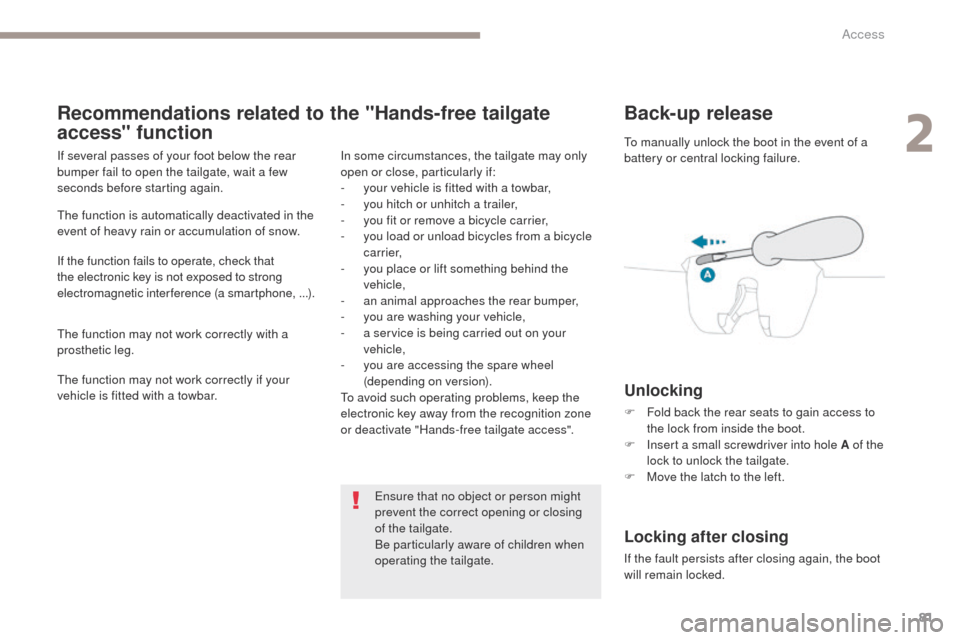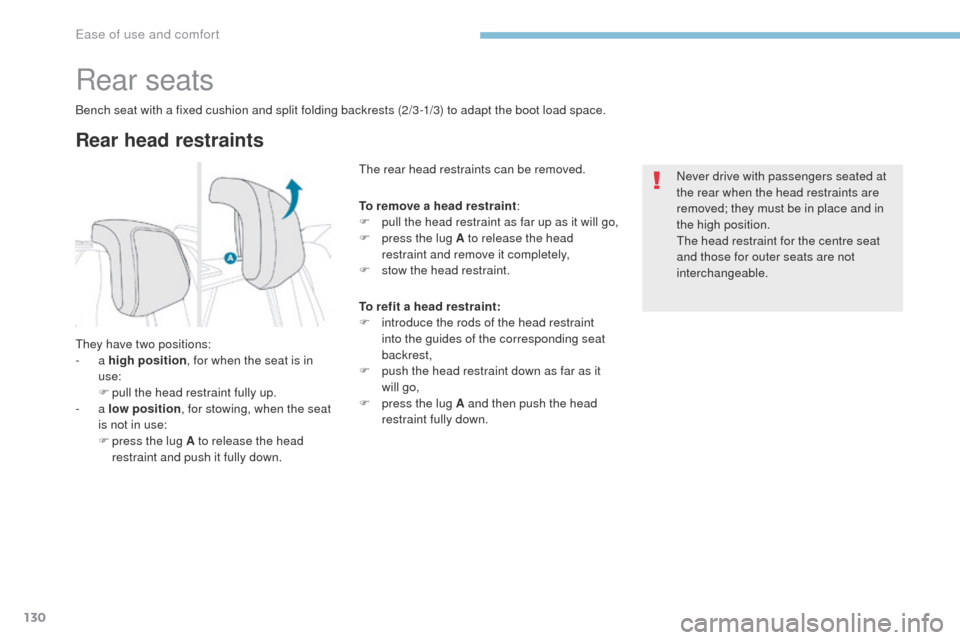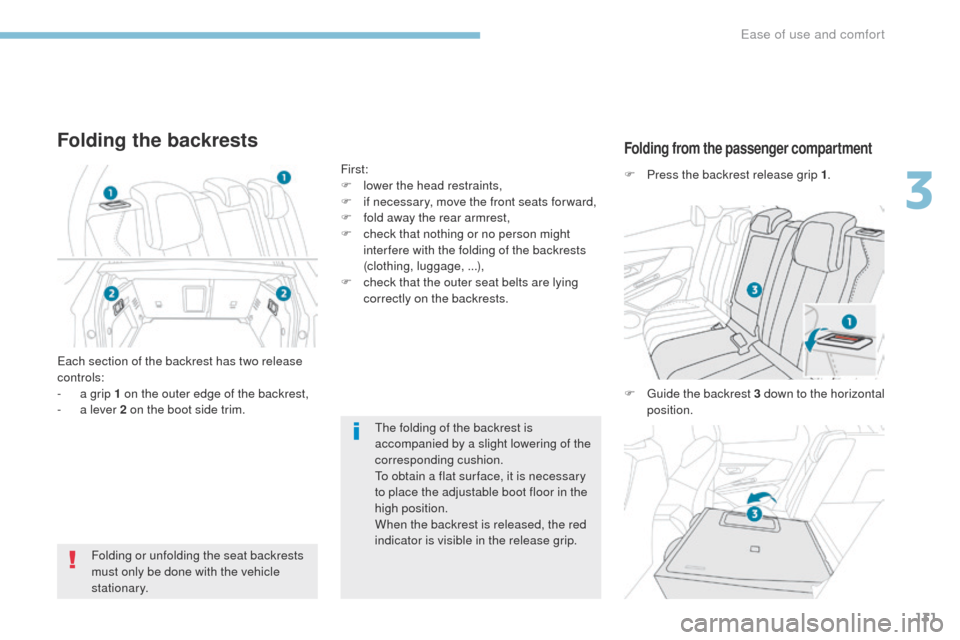Page 80 of 566

78
3008-2_en_Chap02_ouvertures_ed01-2016
"Hands-free" motorised
opening
This movement first unlocks just the
boot, or the vehicle if the latter was
locked.
F
W
ith the electronic key of the Keyless Entry
and Starting system on your person,
F
U
se the "hands-free" access E by passing
a foot rapidly below the rear bumper.
The command is confirmed by an audible
signal.
The tailgate opens, either completely by
default, or to the memorised position. Ensure that you are steady on your feet
before passing a foot rapidly below the
rear bumper.
Take care not to touch the exhaust
system, which may be hot - Risk of
burns! Passing your foot rapidly below the
bumper again while the tailgate is
opening interrupts the movement.
A third pass of your foot reverses the
direction of movement.
"Hands-free" motorised closing
F With the electronic key of the Keyless Entry
and Starting system on your person,
F
U
se the "hands-free" access E by passing
a foot rapidly below the rear bumper.
The command is confirmed by an audible
signal.
Passing your foot rapidly below the
bumper again while the tailgate is
closing interrupts the movement.
A third pass of your foot reverses the
direction of movement.Activation / deactivation of the
Hands-Free Tailgate Access function
is done in the Driving menu of the
touch screen.
This function is deactivated by default.
Access
Page 83 of 566

81
3008-2_en_Chap02_ouvertures_ed01-2016
Back-up release
Unlocking
F Fold back the rear seats to gain access to the lock from inside the boot.
F
I
nsert a small screwdriver into hole A of the
lock to unlock the tailgate.
F
M
ove the latch to the left.
Locking after closing
If the fault persists after closing again, the boot
will remain locked. To manually unlock the boot in the event of a
battery or central locking failure.
Recommendations related to the "Hands-free tailgate
access" function
If several passes of your foot below the rear
bumper fail to open the tailgate, wait a few
seconds before starting again.
The function is automatically deactivated in the
event of heavy rain or accumulation of snow.
If the function fails to operate, check that
the electronic key is not exposed to strong
electromagnetic interference (a smartphone, ...).
The function may not work correctly with a
prosthetic leg.
The function may not work correctly if your
vehicle is fitted with a towbar. In some circumstances, the tailgate may only
open or close, particularly if:
-
y
our vehicle is fitted with a towbar,
-
y
ou hitch or unhitch a trailer,
-
y
ou fit or remove a bicycle carrier,
-
y
ou load or unload bicycles from a bicycle
c a r r i e r,
-
y
ou place or lift something behind the
vehicle,
-
an
animal approaches the rear bumper,
-
y
ou are washing your vehicle,
-
a s
ervice is being carried out on your
vehicle,
-
y
ou are accessing the spare wheel
(depending on version).
To avoid such operating problems, keep the
electronic key away from the recognition zone
or deactivate "Hands-free tailgate access".
Ensure that no object or person might
prevent the correct opening or closing
of the tailgate.
Be particularly aware of children when
operating the tailgate.
2
Access
Page 107 of 566

105
3008-2_en_Chap03_ergonomie-et-confort_ed01-2016
Stop & Start
The heating and air conditioning
systems only work when the engine is
running.
To maintain a comfortable temperature
in the passenger compartment, you can
temporarily deactivate the Stop & Start
system.
For more information on Stop & Star t,
refer to the corresponding section.
In order for these systems to be fully effective, follow the operation and maintenance
guidelines below:
F
T
o obtain an even air distribution, take care not to obstruct the exterior air intake grilles
located at the base of the windscreen, the nozzles, the vents and the air outlets, as well
as the air extractor located in the boot.
F
D
o not cover the sunshine sensor, located on the dashboard; this is used for regulation
of the air conditioning system.
F
O
perate the air conditioning system for at least 5 to 10 minutes, once or twice a month
to keep it in per fect working order.
F
E
nsure that the passenger compartment filter is in good condition and have the filter
elements replaced regularly.
W
e recommend the use of a combined passenger compartment filter. Thanks to
its special active additive, it contributes to the purification of the air breathed by the
occupants and the cleanliness of the passenger compartment (reduction of allergic
symptoms, bad odours and greasy deposits).
F
T
o ensure correct operation of the air conditioning system, you are also advised to have
it checked regularly as recommended in the warranty and maintenance record.
F
I
f the system does not produce cold air, switch it off and contact a PEUGEOT dealer or
a qualified workshop.
When towing the maximum load on a steep gradient in high temperatures, switching off the
air conditioning increases the available engine power and so improves the towing ability. The condensation created by the air
conditioning results in a discharge
of water under the vehicle which is
perfectly normal.
If after an extended stop in sunshine,
the interior temperature is very
high, first ventilate the passenger
compartment for a few moments.
Put the air flow control at a setting high
enough to quickly change the air in the
passenger compartment.
The air conditioning system does not
contain chlorine and does not present
any danger to the ozone layer.
Recommendations for ventilation and air conditioning
3
Ease of use and comfort
Page 132 of 566

130
3008-2_en_Chap03_ergonomie-et-confort_ed01-2016
Rear seats
Rear head restraints
Bench seat with a fixed cushion and split folding backrests (2/3 -1/3) to adapt the boot load space.
They have two positions:
- a high position , for when the seat is in
use:
F
p
ull the head restraint fully up.
-
a low position , for stowing, when the seat
is not in use:
F
p
ress the lug A to release the head
restraint and push it fully down. The rear head restraints can be removed.
Never drive with passengers seated at
the rear when the head restraints are
removed; they must be in place and in
the high position.
The head restraint for the centre seat
and those for outer seats are not
interchangeable.
To remove a head restraint
:
F
p
ull the head restraint as far up as it will go,
F
p
ress the lug A to release the head
restraint and remove it completely,
F
s
tow the head restraint.
To refit a head restraint:
F
i
ntroduce the rods of the head restraint
into the guides of the corresponding seat
backrest,
F
p
ush the head restraint down as far as it
will go,
F
p
ress the lug A and then push the head
restraint fully down.
Ease of use and comfort
Page 133 of 566

131
3008-2_en_Chap03_ergonomie-et-confort_ed01-2016
The folding of the backrest is
accompanied by a slight lowering of the
corresponding cushion.
To obtain a flat sur face, it is necessary
to place the adjustable boot floor in the
high position.
When the backrest is released, the red
indicator is visible in the release grip.
Folding from the passenger compartment
F Press the backrest release grip 1.
F
G
uide the backrest 3 down to the horizontal
position.
Folding the backrests
Each section of the backrest has two release
controls:
-
a g
rip 1 on the outer edge of the backrest,
-
a l
ever 2 on the boot side trim. First:
F
l
ower the head restraints,
F
i
f necessary, move the front seats for ward,
F
f
old away the rear armrest,
F
c
heck that nothing or no person might
inter fere with the folding of the backrests
(clothing, luggage, ...),
F
c
heck that the outer seat belts are lying
correctly on the backrests.
Folding or unfolding the seat backrests
must only be done with the vehicle
stationary.
3
Ease of use and comfort
Page 134 of 566
132
3008-2_en_Chap03_ergonomie-et-confort_ed01-2016
Returning the backrests to
their original positionFolding from the boot
F Pull the backrest release lever 2 towards you.
The backrest 3 folds fully onto the cushion. First check that the outer seat belts are
lying vertically alongside the backrest
latching rings.
F
P
ut the backrest 3 in the upright position
and push on it to latch it home.
F
C
heck that the red indicator is no longer
visible in the release grip 1 .
F
E
nsure that the outer seat belts are not
trapped during the manoeuvre.
Caution, a backrest that has not latched
correctly compromises the safety of
passengers in the event of sudden
braking or an accident.
The contents of the boot may be thrown
forward - Risk of serious injury!
Ease of use and comfort
Page 136 of 566
134
3008-2_en_Chap03_ergonomie-et-confort_ed01-2016
Rear armrest
F Lower the rear armrest for a more comfortable position.
The armrest incorporates two cup holders.
Ski flap
Opening
F Lower the rear armrest.
F P ull the flap handle downwards.
F
L
ower the flap.
F
L
oad the objects from inside the boot.
Comfort and storage arrangement for rear
passengers.
Arrangement for storing and transporting long
objects.
Ease of use and comfort
Page 137 of 566
135
3008-2_en_Chap03_ergonomie-et-confort_ed01-2016
Boot fittings
1. Load space cover
2. 12 V accessor y socket (120 W)
3.
B
oot lamp
4.
R
ear seat folding controls
5.
Hoo
ks
6.
S
towing rings
7.
A
djustable boot floor (2 positions )
8.
S
torage well / Tool box under the floorThe stowing rings are designed for
securing luggage by attaching a
retaining net to the rings.
Such nets are available as an option or
as an accessory.
For more information, contact a
PEUGEOT dealer.
For the installation of a high load
retaining net, refer to the corresponding
section.
3
Ease of use and comfort